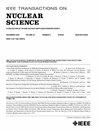利用弯曲膨胀脉冲增强脉冲膨胀分幅相机时间均匀性
IF 1.9
3区 工程技术
Q3 ENGINEERING, ELECTRICAL & ELECTRONIC
引用次数: 0
摘要
脉冲扩张分幅相机(PDFC)是一种具有高时间分辨率的二维超快诊断设备。在高能物理实验中,它可以用于研究相关的瞬态过程和超快动力学。然而,线性膨胀脉冲(DP)沿光电阴极(PC)的传输可能导致PDFC中的TR不均匀性,导致不同时间点捕获的物理信息发生变化,并可能导致观测结果失真。为了解决这一问题,采用绝缘栅双极晶体管(IGBT)、变压器线圈和高通滤波器设计了一种弯曲DP (CDP),并研究了其在改善时间均匀性(TU)方面的应用。研究结果表明,IGBT电路可以产生振幅非线性上升的脉冲电位,其斜率范围为0.132 ~ 3.39 V/ps。在-3 kv PC电压、电子束(EB)初始时间宽度为10 ps、漂移距离为500 mm的条件下,应用于长度为80 mm的PC,可使EB膨胀比(EBDR)沿PC的平均相对误差(ARE)降至0.63% (EBDR: $11.68\times $ ~ $11.81\times $)。这代表了TU的显著增强,与线性的7.20% ($3.84\times $ - $4.42\times $)相比。此外,基于EBDR沿PC的最大相对误差进行评价时,与多脉冲融合的多组高精度时间同步要求(MPF, 9.14%, $9.52\times $ - $10.39\times $)和v型脉冲叠加(VSPS, 26.15%, $11.28\times $ - $14.23\times $)相比,CDP达到了1.11%,基于IGBT技术的CDP只需要单组时间同步即可有效增强TU。CDP也可以应用于一维条纹相机,以减轻动态时空畸变。本文章由计算机程序翻译,如有差异,请以英文原文为准。
Enhancing Temporal Uniformity in Pulse-Dilation Framing Camera Using Curved-Dilation-Pulse
The pulse-dilation framing camera (PDFC) is a 2-D ultrafast diagnostic device with high temporal resolution (TR). In high-energy physics experiments, it can be used to investigate related transient processes and ultrafast dynamics. Nevertheless, the transmission of linear dilation pulse (DP) along the photocathode (PC) may lead to TR non-uniformity in the PDFC, causing variations in the physical information captured at different time points and potentially resulting in distorted observations. To address this issue, a curved DP (CDP) was designed using an insulated gate bipolar transistor (IGBT), transformer coils, and high-pass filters, and its application in improving temporal uniformity (TU) was investigated. The research findings indicate that the IGBT circuit can generate a CDP with non-linearly rising amplitude and a slope ranging from 0.132 to 3.39 V/ps. Under conditions of -3-kV PC voltage, an initial time width of 10 ps for the electron beam (EB), and a drift distance of 500 mm, when applied to an 80-mm long PC, the average relative error (ARE) of EB dilation ratio (EBDR) along PC can be minimized to 0.63% (EBDR: $11.68\times $ – $11.81\times $ ). This represents a significant enhancement in TU compared to the 7.20% ( $3.84\times $ – $4.42\times $ ) achieved with the linear ones. Furthermore, when evaluated based on the maximum relative error of EBDR along PC, the CDP achieves 1.11% compared with the multi-group high-precision time synchronization requirements of multi-pulse fusion (MPF, 9.14%, $9.52\times $ – $10.39\times $ ) and V-shaped pulse superposition (VSPS, 26.15%, $11.28\times $ – $14.23\times $ ), the CDP based on IGBT technology only requires a single group of time synchronization to effectively enhance TU. Meanwhile, the CDP can also be applied to a 1-D streak camera for mitigating dynamic spatio-temporal distortion.
求助全文
通过发布文献求助,成功后即可免费获取论文全文。
去求助
来源期刊

IEEE Transactions on Nuclear Science
工程技术-工程:电子与电气
CiteScore
3.70
自引率
27.80%
发文量
314
审稿时长
6.2 months
期刊介绍:
The IEEE Transactions on Nuclear Science is a publication of the IEEE Nuclear and Plasma Sciences Society. It is viewed as the primary source of technical information in many of the areas it covers. As judged by JCR impact factor, TNS consistently ranks in the top five journals in the category of Nuclear Science & Technology. It has one of the higher immediacy indices, indicating that the information it publishes is viewed as timely, and has a relatively long citation half-life, indicating that the published information also is viewed as valuable for a number of years.
The IEEE Transactions on Nuclear Science is published bimonthly. Its scope includes all aspects of the theory and application of nuclear science and engineering. It focuses on instrumentation for the detection and measurement of ionizing radiation; particle accelerators and their controls; nuclear medicine and its application; effects of radiation on materials, components, and systems; reactor instrumentation and controls; and measurement of radiation in space.
 求助内容:
求助内容: 应助结果提醒方式:
应助结果提醒方式:


